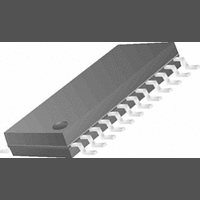LM87CIMT National Semiconductor, LM87CIMT Datasheet - Page 17

LM87CIMT
Manufacturer Part Number
LM87CIMT
Description
Temperature Sensor IC
Manufacturer
National Semiconductor
Datasheet
1.LM87CIMT.pdf
(34 pages)
Specifications of LM87CIMT
Peak Reflow Compatible (260 C)
No
Ic Function
Temperature Sensor IC
Supply Voltage Max
3.8V
Leaded Process Compatible
No
Mounting Type
Surface Mount
Operating Temperature Range
-40°C To +125°C
Temperature Sensor Function
Temp Sensor
Interface Type
Serial (2-Wire)
Output Type
Digital
Package Type
TSSOP
Operating Temperature (min)
-40C
Operating Temperature (max)
125C
Operating Temperature Classification
Automotive
Operating Supply Voltage (typ)
3.3V
Lead Free Status / RoHS Status
Contains lead / RoHS non-compliant
Lead Free Status / RoHS Status
Contains lead / RoHS non-compliant
Available stocks
Company
Part Number
Manufacturer
Quantity
Price
Part Number:
LM87CIMT
Manufacturer:
NS/国半
Quantity:
20 000
Part Number:
LM87CIMTX
Manufacturer:
NS/国半
Quantity:
20 000
Company:
Part Number:
LM87CIMTX/NOPB
Manufacturer:
NS/TI
Quantity:
110
(Non-Linear Scale for Clarity)
FIGURE 8. 8-bit Temperature-to-Digital Transfer Function
8.1 Temperature Data Format
Temperature data can be read from the Temperature, T
setpoint, T
isters; and written to the T
Hardware Temperature limit registers. T
setpoint, Hardware Temperature Limit, and Temperature data
is represented by an 8-bit, two's complement word with an
LSB (Least Significant Bit) equal to 1°C:
8.2 Internal Temperature Measurement
The LM87 internal temperature is monitored using a junction
type temperature sensor.
8.3 Remote Temperature Measurement
The LM87 monitors the temperature of remote semiconductor
devices using the p-n junction temperature sensing principal.
Up to two remote IC, diode or bipolar transistor temperatures
can be monitored. The remote measurement channels have
been optimized to measure the remote diode of a Pentium II
processor. A discrete diode or bipolar transistor can also be
used to sense the temperature of external objects or ambient
air. The 2N3904 NPN transistor base emitter junction per-
forms well in this type of application. When using a 2N3904,
the collector should be connected to the base to provide a
device that closely approximates the characteristics of the
Pentium II PNP monitoring diode.
When using two external 2N3904 sensors, the D− inputs
should be connected together. This provides the best possi-
Temperature
+125°C
+1.0°C
−1.0°C
+25°C
−25°C
−40°C
+0°C
LOW
setpoint, and Hardware Temperature limit reg-
0111 1101
0001 1001
0000 0001
0000 0000
1111 1111
1110 0111
1101 1000
HIGH
Binary
setpoint, T
Digital Output
HIGH
LOW
setpoint, T
setpoint, and
Hex
7Dh
D8h
19h
01h
00h
FFh
E7h
HIGH
10099524
LOW
17
ble accuracy by compensating for differences between the
2N3904 and Pentium II sensors.
During each conversion cycle, the remote monitoring inputs
perform an external diode fault detection sequence. If the D+
input is shorted to V
ing will be +127°C, and bit 6 or bit 7 of Interrupt Status
Register 2 will be set. If D+ is shorted to GND or D−, the tem-
perature reading will be 0°C and bit 6 or 7 of Interrupt Status
Register 2 will not be set.
8.4 Accuracy Effects of Diode Non-Ideality Factor
The technique used in today's remote temperature sensors is
to measure the change in V
of a diode. For a bias current ratio of N:1, this difference is
given as:
where:
•
•
•
•
•
The temperature sensor then measures ΔV
to digital data. In this equation, k and q are well defined uni-
versal constants, and N is a parameter controlled by the
temperature sensor. The only other parameter is η, which de-
pends on the diode that is used for measurement. Since
ΔV
be distinguished from variations in temperature. Since the
non-ideality factor is not controlled by the temperature sensor,
it will directly add to the inaccuracy of the sensor. For the
Pentium II Intel specifies a ±1% variation in η from part to part.
As an example, assume a temperature sensor has an accu-
racy specification of ±3°C at room temperature of 25°C and
the process used to manufacture the diode has a non-ideality
variation of ±1%. The resulting accuracy of the temperature
sensor at room temperature will be:
.
The additional inaccuracy in the temperature measurement
caused by η, can be eliminated if each temperature sensor is
calibrated with the remote diode that it will be paired with.
8.5 PCB Layout Recommendations for Minimizing Noise
In a noisy environment, such as a processor mother board,
layout considerations are very critical. Noise induced on
traces running between the remote temperature diode sensor
and the LM87 can cause temperature conversion errors. The
following guidelines should be followed:
1.
2.
3.
BE
η is the non-ideality factor of the process the diode is
manufactured on,
q is the electron charge,
k is the Boltzmann's constant,
N is the current ratio,
T is the absolute temperature in °K.
Place a 0.1 μF power supply bypass capacitor as close
as possible to the V
capacitor as close as possible to the D+ and D− pins.
Make sure the traces to the 2.2 nF capacitor are
matched.
Ideally, the LM87 should be placed within 10 cm of the
Processor diode pins with the traces being as straight,
short and identical as possible.
Diode traces should be surrounded by a GND guard ring
to either side, above and below if possible. This GND
guard should not be between the D+ and D− lines. In the
is proportional to both η and T, the variations in η cannot
T
ACC
= ± 3°C + (±1% of 298°K) = ±6°C
CC
or floating then the temperature read-
CC
BE
pin and the recommended 2.2 nF
at two different operating points
BE
and converts
www.national.com











